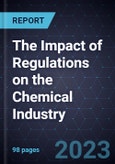New Chemicals Regulations will Create Growth Opportunities Through New Product Development and Advanced Technology Strategies
This study analyzes the key regulations in the chemical industry and examines how various stakeholders are responding to the changing regulatory landscape. It serves as a regulatory handbook and helps understand how regulations have been evolving in the chemical industry. With regulatory authorities increasingly responding to the rising concerns over the effect of certain chemicals on human health and the environment, it is crucial to examine the potential impact of these regulations on different business segments.
The study also analyzes the significant variations in regulations and regulatory trends across regions. Regulations often trigger product development, and the subsequent adoption of those products can affect the market, even in regions where regulations are not enforced. These are crucial industry dynamics that can potentially impact various aspects of a business.
This analysis covers the regulations from four main product segments: coatings, adhesives, and sealants (CAS); plastics and polymers; fuels and lubricants; and process chemicals. The key process chemicals covered in the study include those used in electrical and electronic (E&E), water and wastewater treatment (WWT), and mining applications. Certain regulations also stem from end industries such as automotive, marine, construction, energy, food and beverage, etc., and the analysis covers the most important and relevant ones within its scope.
Some chemicals have an impact on a wide range of industries and product segments. For example, chemicals such as polyfluoroalkyl substances (PFAS) and phthalates have been affecting several product markets. This study identifies such issues and examines how the stakeholders in different product markets are responding to the evolving regulations for these chemicals. The study concludes by identifying the growth opportunities emerging from the changes in the regulatory landscape for market players and stakeholders to leverage.
Table of Contents
Companies Mentioned (Partial List)
A selection of companies mentioned in this report includes, but is not limited to:
- Solenis








